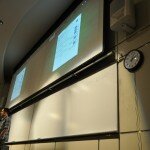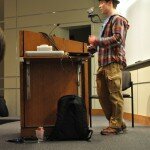FUDCon Photos – the morning of Day 1
Here are some of the photos i took during the morning of day 1 of FUDCon Kansas. I am uploading them as the day goes along on the +
- The shuttle was interesting. :)
- waiting to start
- The Official Fudcon Kansas shirt
The morning before FUDCon 2013
- The shuttle was interesting. :)
- waiting to start
- The Official Fudcon Kansas shirt
No Logout option in Fedora 18
In Fedora 18, GNOME 3.6 has some more tweaks and changes to how the User menu works. One change that may trip up regular Fedora / gnome-shell users is that there is no “Logout” option in the user menu (the menu that drops down from your name in the top right corner of the shell).
Basically, the change is this:
if you only have one user set up on a system, and only have one Desktop environment installed (i.e. just GNOME) then the logout option is not shown.
However, this comes with the following caveat: if you install a new desktop other than GNOME3, you will need to manually restart the shell (press Alt+F2, type ‘r’, and hit enter) or reboot for the logout option to start displaying.
I don’t care, just re-enable the logout in Fedora 18
if you only have one user, and only one desktop enviroment, and still want the log out option to display, the GNOME developerss have also added in an option to be able to persistently keep the logout option in the user menu.
To make the logout option always appear:
- First open up the dconf editor (fedora package “dconf-editor”), and navigate to the org > gnome > shell key.
- Check the option “always-show-log-out” (pictured below in the screenshot), to always show the logout option. Note, however, that a restart of the shell or a reboot may be required for this option to start working.
Fedora 18 Released, print your sleeve!
Celebrate the release of Fedora 18 by printing out and folding a paper sleeve for your disc media. This release, we have all 12 of the media covers available as printable-at-home, foldable sleeves. There are also a set of graphical instructions to help you fold.

PDFs for the sleeves and instructions are indexed on the wiki, or you can use the following links:
Bash oneliner to batch export PDFs in inkscape
Note to Self
Here is your quick bash oneliner to batch export PDFs from SVGs using the inkscape command line.
for i in *.svg; do f=${i%.*}; inkscape --export-pdf="$f.pdf" "$f.svg"; done;
Home-printable, foldable disc sleeve for Fedora
While working on the (high-colour / goes to the professional printer / you have to worry about CMYK) disc sleeves for the upcoming fedora release, i stumbled on a print-at-home foldable disc sleeve for fedora 17.
So, i decided to take this concept, make a cover that could be printed onto white paper. So, download the PDF, and try it out for yourself! Note that this is not the final design for Fedora 18!


Outreach Program for Women
Fedora is participating in the GNOME Outreach Program for Women (OPW). Basically, it is a program similar to the Google Summer of Code, but is targeted solely at female contributors. In fact, the GNOME OPW started after GNOME received 0 female applicants from a total of 181 applications for the 2006 Google Summer of Code. There are many different factors and theories as to why this discrepancy occurs, but Marina from the GNOME project really sums it up well :
Most successful applicants were already passionate about Free Software, but were not sure where to start – this is something we hear repeatedly from applicants. In our society, women are not as encouraged to take part in the Free Software development and do not typically have a social circle that would support them in doing so. Besides, Free Software as a community has not always been friendly to women participation with being homogeneous, making sexist comments and tolerating incidents of harassment.
Limiting the applicants to just females provides an easy, approachable way to get more women involved in FOSS development. Ultimately, as the FOSS development space becomes more balanced, we should no longer need programs like the OPW, as our community will be more welcoming and open to all.
2%

the Anaconda interface redesign
*Update November 12, 2012 to add links to posts by Mackenzie that discussed the redesign also*
The forthcoming Fedora 18 release will contain a seriously overhauled version of the tool used to install Fedora, Anaconda. The most highly visible change to Anaconda (yes, there were other improvements too) is the overhaul of the graphical installer interface itself (codenamed newui by the anaconda developers).
When I install Fedora, i typically install by the defaults. I just want the default partitioning. I just want the default package sets. I just want the newest, shiniest fedora on my laptop now.
The old Anaconda (Fedora 17 and earlier)
Using the previous installer, (up until Fedora 17), installing with just the defaults involved clicking though several pages, none of which I typically change, until finally I get to the all important “Install” button. Then I get a well deserved coffee to revive my clicking finger.

New Anaconda (Fedora 18 onwards)
The new anaconda interface now presents you with a single page of information right at the beginning of the install process. (After choosing your language). This page basically outlines to you what defaults have been chosen, and lets you drill down into them to make changes (if you need to).
So, for the fresh-install, love the defaults user like me, it’s pretty close to a one-click install. For the user that wants to be able to tweak their settings before installation, the single page gives you an overview of the installation settings, and lets you change just the ones you want.
Where did these interface changes come from?
These design changes have been in the works for a while. Even though I personally have not been heavily involved with the design process itself, a recent post from David Cantrell to fedora-devel outlines how long this has been worked on:
For the newui work, initial discussions started at FUDCon Tempe, through the year, and then again at FUDCon Blacksburg. After that, more design work continued, soliciting for user feedback as much as possible.
I have also been following the design discussion that has surrounded the development of the anaconda newui through the series of blogposts (Starting in June 2011) from Máirín Duffy:
- June 2011 – Making Fedora easier to use & the Installer UX redesign
- July 2011 – Anaconda Language & Keyboard Layout Selection
- September 2011 – Anaconda Whiteboards
- September 2011 – Anaconda’s flow
- September 2011 – Where would you like your install today?
- October 2011 – Slicing and dicing disks (first draft)
- December 2011 – What’s your partitioning persona? And, the partitioning UI thus far.
- April 2012 – Rough thoughts on reclaiming space from partitions during installation
- April 2012 – Drag / resize handles
- April 2012 – Reclaiming space from partitions during installation Round 2
- May 2012 – More Anaconda Custom Partitioning
- July 2012 – Reclaiming space from partitions during installation Round 3
- September 2012 – Anaconda Bootloader, Reusing /home, Assigning partitions to disks
*Update November 12, 2012* — As pointed out by Máirín in the comments, the Fedora Design Summer Intern, Mackenzie also posted designs and requests for comments on the anaconda redesign:
- June 2012 – Error Handling in Anaconda
- June 2012 – Anaconda Errors, Part 2
- June 2012 – Anaconda Errors, a comprehensive gallery
- July 2012 – Kickstart Auto Dectection
It is also important to note that the newui is a huge overhaul, and a lot of work for the anaconda developers. A lot of the functionality that is in the design mockups will not be in Fedora 18, it is slated for inclusion in Fedora 19. According to David Cantrell, this was the plan from the beginning:
we new it would be absolutely impossible to deliver all functionality in a single release. So from the beginning we were planning to stage the newui work across multiple releases.
How to help
This is a huge change for the better for the Fedora installer. The best way to help is to try out the Beta versions of Fedora 18 and provide feedback to the anaconda development team via bugzilla or IRC (#anaconda)

























